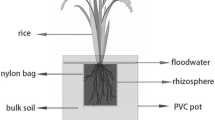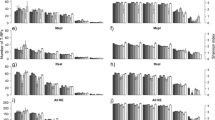Abstract
Molecular methods were used to study variation in the taxonomic structure of bacterial, archaeal, and fungal communities in soil samples taken along a salinity gradient from a solonchak in the vicinity of Lake Akkol’ (Shingirlau, Kazakhstan). Soils from arable fields located 195 km from the solonchak served as the control. Total DNA was isolated from every sample and analyzed by T-RFLP and real-time PCR. Salinization was found to be the main ecological factor determining the structure of soil microbial community in the study region. The values of Simpson’s index characterizing the diversity of this community proved to be similar in all the samples, which, however, significantly differed in the taxonomic composition of microorganisms. A significantly increased content of archaea was revealed in the sample with the highest salinity. The results of this study show that the structure of soil microbial community reflects specific features of a given soil and can be used as an indicator of its ecological state.
Similar content being viewed by others
References
I. P. Aidarov and E. I. Pankova, “Salt Accumulation and Its Control on the Plains of Central Asia,” Pochvovedenie, No. 6, 676–684 (2007) [Eur. Soil Sci. 40 (6), 608–615 (2007)].
E. E. Andronov, S. N. Petrova, E. P. Chizhevskaya, et al., “Influence of Introducing the Genetically Modified Strain Sinorhizobium meliloti ACH-5 on the Structure of the Soil Microbial Community,” Mikrobiologiya 78(4), 525–534 (2009) [Microbiology 78 (4), 474–482 (2009)].
L. A. Vorob’eva, Chemical Analysis of Soils (Izd. Mosk. Gos. Univ., Moscow, 1998) [in Russian].
M. E. Kotenko and T. A. Zubkova, “The Impact of Salt-Affected Soils on the State of Microbial Community,” Vestn. Kazansk. Gos. Agrarn. Univ. 7(1), 138–141 (2008).
E. I. Pankova, L. A. Vorob’eva, A. F. Novikova, et al., Salt-Affected Soils of Russia (IKTs-Akademkniga, Moscow, 2006) [in Russian].
S. N. Petrova, E. E. Andronov, A. G. Pinaev, and E. V. Pershina, “Prospects for Using the Methods of Molecular Genetic Analysis in Soil Ecology,” Vestn. Orlovsk. Gos. Agrarn. Univ., 26(5), 45–48 (2010).
A. Bachar, A. Ashraf, M. Ines, et al., “Soil Microbial Abundance and Diversity Along a Low Precipitation Gradient,” Microb. Ecol. 60(2), 453–461 (2010).
T. M. Caton, I. R. Caton, L. R. Witte, and M. A. Schneegurt, “Archaeal Diversity at the Great Salt Plains of Oklahoma Described by Cultivation and Molecular Analyses,” Microb. Ecol. 58(3), 519–528 (2009).
A. Chen, K. Ueda, Y. Sekiguchi, et al., “Molecular Detection and Direct Enumeration of Methanogenic Archaea and Methanotrophic Bacteria in Domestic Solid Waste Landfill Soils,” Biotechnol. Lett. 25(18), 1563–1569 (2004).
R. Daniel, “The Metagenomics of Soil,” Nature Rev. Microbiol., No. 3, 470–478 (2005).
C. Demergasso, E. O. Casamayor, G. Chong, et al., “Distribution of Prokaryotic Genetic Diversity in Athalassohaline Lakes of the Atacama Desert, Northern Chile,” FEMS Microbiol. Ecol. 1(48), 57–69 (2004).
N. Fierer and R. B. Jackson, “The Diversity and Biogeography of Soil Bacterial Communities,” Proc. Natl. Acad. Sci. USA 103(3), 626–631 (2006).
N. Fierer, J. A. Jackson, R. Vilgalys, and R. B. Jackson, “Assessment of Soil Microbial Community Structure by Use of Taxon-Specific Quantitative PCR Assays,” Appl. Environ. Microbiol. 71, 4117–4120 (2005).
A. Ganley and T. Kobayashi, “Total rDNA Repeat Variation Revealed by Whole-Genome Shotgun Sequence Data,” Genome Res., No. 17, 184–191 (2007).
R. C. Garber, B. G. Turgeon, E. U. Selker, and O. C. Yoder, “Organization of Ribosomal RNA Genes in the Fungus Cochliobolus heterostrophus,” Curr. Genet. 14(6), 573–582 (1988).
E. B. Hollister, A. S. Engledow, A. J. M. Hammett, et al., “Shifts in Microbial Community Structure along an Ecological Gradient of Hypersaline Soils and Sediments,” The ISME J., No. 4, 829–838 (2010).
O. Hammer, D. A. T. Harper, and P. D. Ryan, “PAST: Paleontological Statistics Software Package for Education and Data Analysis,” Paleontol. Electronica 4(9), 1–9 (2001).
J. Handelsman, “Metagenomics: Application of Genomics to Uncultured Microorganisms,” Microbiol. Molec. Biol. Rev. 68(4), 669–685 (2004).
S. Höppener-Ogawa, J. H. J. Leveau, W. Smant, et al., “Specific Detection and Real-Time PCR Quantification of Potentially Mycophagous Bacteria Belonging to the Genus Collimonas in Different Soil Ecosystems,” Appl. Environ. Microbiol. 73(13), 4191–4197 (2007).
J. B. Hughes Martiny, B. J. M. Bohannan, J. H. Brown, et al., “Microbial Biogeography: Putting Microorganisms on the Map,” Nature Rev. Microbiol., No. 4, 102–112 (2006).
M. A. Innis and D. H. Gelfand, PCR Protocols: A Guide to Methods and Applications (Academic, San Diego, 1990).
D. J. Lane, “16S/23S rRNA Sequencing,” in Nucleic Acid Techniques in Bacterial Systematics, Ed. by E. Stackebrandt and M. Goodfellow (John Wiley and Sons, New York, 1991).
Z. M. Lee, C. Bussema III, and Th. M. Schmidt, “RrnDB: Documenting the Number of rRNA and tRNA Genes in Bacteria and Archaea,” Nucleic Acids Res. 37(1), D489–D493.
C. A. Lozupone and R. Knight, “Global Patterns in Bacterial Diversity,” Proc. Natl. Acad. Sci. USA 104(27), 11436–11440 (2007).
G. Malferrari, E. Monferini, P. DeBlasio, et al., “High-Quality Genomic DNA from Human Whole Blood and Mononuclear Cells,” BioTechniques 33(6), 1228–1230 (2002).
F. C. Michel Jr. and S. M. Sciarini, “Fragsort 4.0, a Tool for Multiple Restriction Digestion T-RFLP Analysis Based on in Silico Amplification and Digestion of 16S ribosomal RNA Gene Sequences,” Proc. 10th Int. Symp. Microbial Ecol. (ISME-10) (Cancun, Mexico, 2004).
D. J. Mohamed and J. B. Martiny, “Patterns of Fungal Diversity and Composition along a Salinity Gradient,” ISME J. 3 (5), 379–388 (2011).
S. Moskalenko, S. Chabelskaya, M. Philippe, et al., “Viable Nonsense Mutants for the Essential Gene SUP45 of Saccharomyces serevisiae,” BMC Molecul. Biol. 2(4), 1–13 (2003).
M. A. Munson, D. B. Nedwell, and T. M. Embley, “Phylogenetic Diversity of Archaea in Sediment Samples from a Coastal Salt Marsh,” Appl. Environ. Microbiol. 63(12), 4729–4733 (1997).
M. A. O’Malley, “The Nineteenth Century Roots of’ Everything Is Everywhere’,” Nature Rev. Microbiol., No. 5, 647–651 (2007).
A. Oren, “The Ecology of the Extremely Halophilic Archaea,” FEMS Microbiol. Rev. 13(4), 415–439 (1994).
E. Pershina and E. Andronov, “Looking for the Better Way in Studying Soil Microbial Diversity,” Materials of Adaptation to Climate Change in the Baltic Sea Region: Contributions from Plant and Microbial Biotechnology (Mikkeli, Finland, 2010).
L. J. Rothschild and R. L. Mancinelli, “Life in Extreme Environments,” Nature, No. 409, 1092–1101 (2001).
J. Rousk, E. Bååth, Ph. C. Brookes, et al., “Soil Bacterial and Fungal Communities across a pH Gradient in an Arable Soil,” The ISME J, No. 4, 1340–1351 (2010).
B. K. Singh, L. Nazaries, S. Munro, et al., “Use of Multiplex Terminal Restriction Fragment Length Polymorphism for Rapid and Simultaneous Analysis of Different Components of the Soil Microbial Community,” Appl. and Environ. Microbiol. 72(11), 7278–7285 (2006).
R. Sung-Keun, S. Hong, J. Bae, et al., “Estimation of Distribution of a Commensal Thermophile in Soil by Competitive Quantitative PCR and Terminal Restriction Fragment Length Polymorphism Analysis,” J. Microbiol. Biotechnol 11(6), 940–945 (2001).
D. Tsuchiya and M. Taga, “Application of Fibre-FISH (Fluorescence in situ Hybridization) to Filamentous Fungi: Visualization of the rRNA Gene Cluster of the Ascomycete Cochliobolus heterostrophus,” Microbiology, No. 147, 1183–1187 (2001).
D. A. Walsh, R. T. Papke, and F. W. Doolittle, “Archaeal Diversity along a Soil Salinity Gradient Prone to Disturbance,” Environ. Microbiol. 7(10), 1655–1666 (2005).
J. Wendland, R. Pöhlmann, F. Dietrich, et al., “Compact Organization of rRNA Genes in the Filamentous Fungus Ashbya gossypii,” Curr. Genet. 35(6), 618–625.
Y. Yu, Ch. Lee, J. Kim, and S. Hwang, “Group-Specific Primer and Probe Sets to Detect Methanogenic Communities Using Quantitative Real-Time Polymerase Chain Reaction,” Biotechnol. Bioeng. 89(6), 670–679 (2005).
D. G. Zvyagintsev, G. M. Zenova, and G. V. Oborotov, “Moderately Haloalkaliphilic Actinomycetes in Salt-Affected Soils,” Eur. Soil Sci. 42(13), 1515–1520 (2009).
TERRAGENOME [http://www.terragenome.org/]
Author information
Authors and Affiliations
Additional information
Original Russian Text © E.E. Andronov, S.N. Petrova, A.G. Pinaev, E.V. Pershina, S.Zh. Rakhimgalieva, K.M. Akhmedenov, A.V. Gorobets, N.Kh. Sergaliev, 2012, published in Pochvovedenie, 2012, No. 2, pp. 173–183.
Rights and permissions
About this article
Cite this article
Andronov, E.E., Petrova, S.N., Pinaev, A.G. et al. Analysis of the structure of microbial community in soils with different degrees of salinization using T-RFLP and real-time PCR techniques. Eurasian Soil Sc. 45, 147–156 (2012). https://doi.org/10.1134/S1064229312020044
Received:
Published:
Issue Date:
DOI: https://doi.org/10.1134/S1064229312020044




